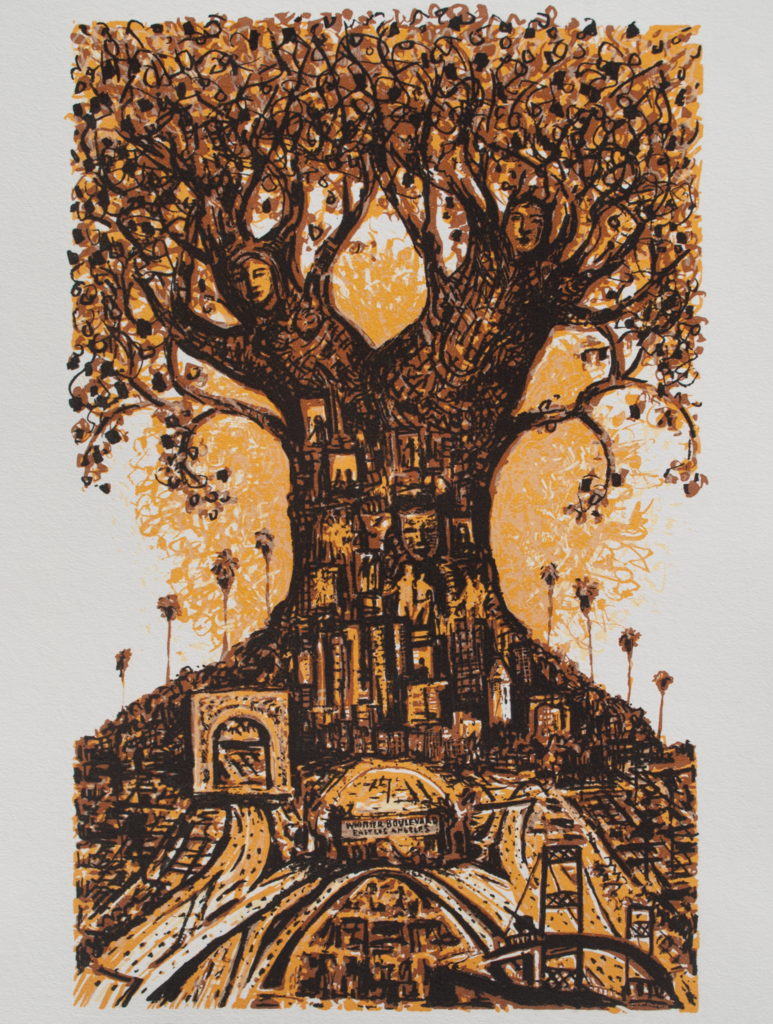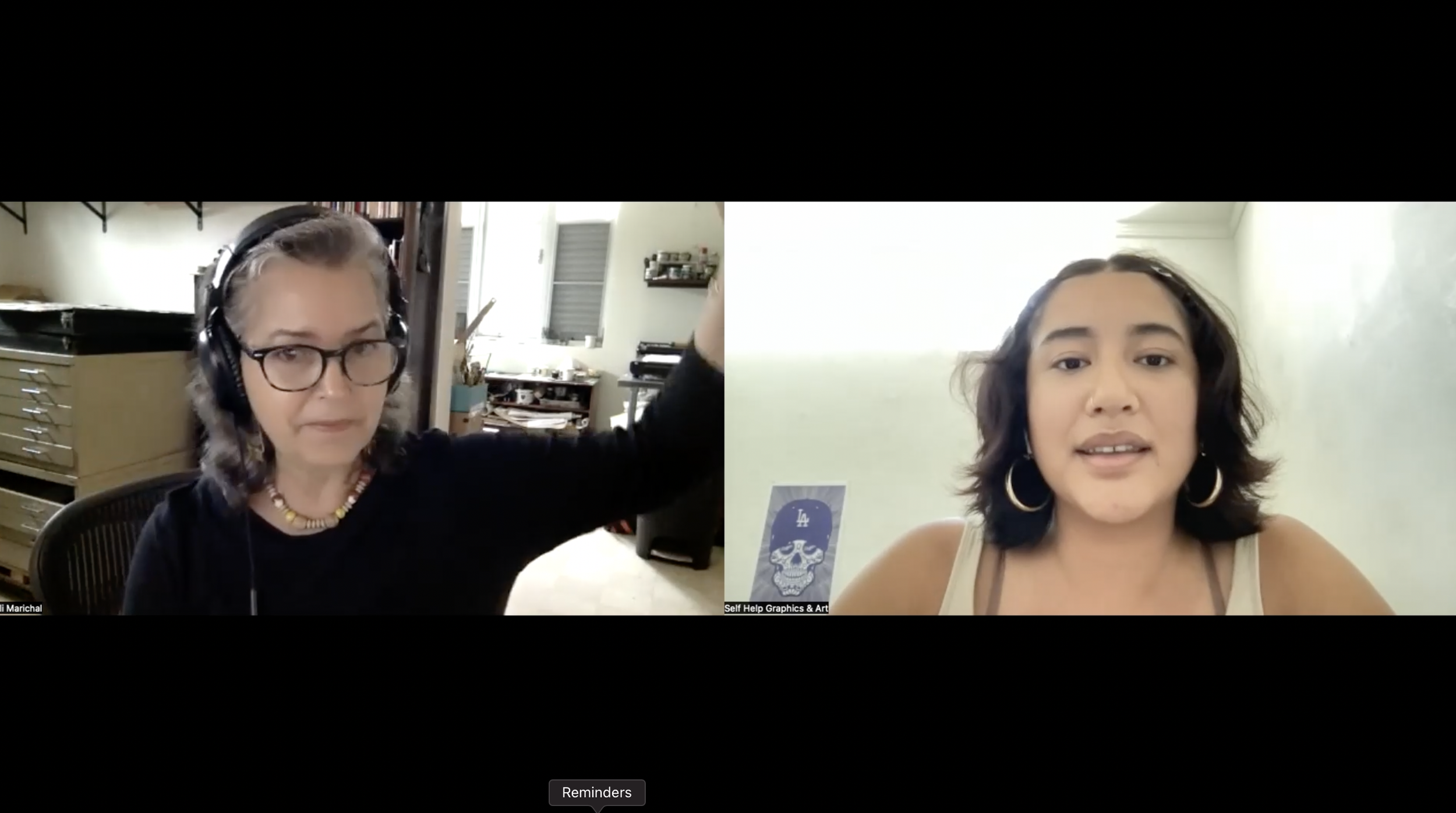Artist Poli Marichal Depicts Memory and Nostalgia Through A Communal Tree for LA
By: Jacqueline Aguirre
I spoke with the artist Poli Marichal to learn more about the print and her art practice. Poli is a multidisciplinary artist based in Puerto Rico whose main practice is printmaking and experimental film. Born in Ponce, Puerto Rico, Poli spent most of her adulthood in Los Angeles, where she found community in East LA and at Self Help Graphics.
Poli created her print, A Communal Tree for LA, in 2016 for the California Community Foundation Centennial Campaign. The print depicts a contrast between nature and industrialization. Poli portrays a giant tree representing a man and a woman with people and buildings within the trunk. Toward the bottom of the print there are different freeways as extensions of the tree, representing the tree roots. Also depicted are LA landmarks like the “Welcome to Whittier’ sign, the 6th St. bridge, and palm trees along the side of the tree. The print’s warm tones emits a hazy feeling to the artwork, evoking memory and nostalgia.
What was the initial thought process behind the print, A Communal Tree for LA?
A: I’ve done a lot of work that deals with nature, trees, and conservation. When they invited me to participate [ in the centennial campaign], I felt that making a tree that incorporated the male and female forms sort of embraced the community and protecting it was a poetic way of approaching the theme of the exhibition and the project itself. I wanted to incorporate geographical landmarks that people could recognize so people could not only see something abstract but also something specific. I was brought up in the countryside. So, as a child, the trees were my playground. I think that experience really marked my connection with nature. So, I incorporate it alot in my work.
Los Angeles is kind of like a hillish human body. The freeways are so necessary and there is such a big space they need to cover. When you think of LA, you also think of freeways. I wanted them to feel like veins of the city or the roots of the trees.
I think I’m more of a symbolic artist. I like to create works of art that focus on expression and to communicate with people about who they are and where they're going. The major questions: life, death, and conservation– A lot of my work deals with making people conscious of the beauty and the sacredness of nature —But also human rights. If we don't respect human life, what are we doing? Every human life is a miracle. When people say “my country” , who determines that? A war? [Borders] weren’t there before. LA used to be Mexico and before it was Mexico it was indigenous land. It was a very violent way of taking land and people have to take responsibility. But, unfortunately that's an ongoing struggle.
The inaccessibility of green space is an issue that many Angelenos face. I know that you grew up in Puerto Rico and are currently living there now, do you see a similar issue back home?
A: Well, everything grows in PR even if you don't take care of it so there’s green all over. Even in the city where there’s a lot of concrete and it's cluttered, there are tons of trees and birds. If they haven’t constructed anything, it's full of plants because it rains so much!
Even if there is development happening over there, people still try to keep green around them?
A: Yeah everyone has something that bears fruit here because a lot of people have rural roots and everyone has relatives in the countryside. So everyone wants to bring their farms to the city. A lot of people I know have huge breadfruit in their houses.
It's great to hear that people still keep that going
A: Most people in general, even younger people keep it going. My nephew is working on a communal orchard with students from the university. He spends a lot of time there. They give the surplus to the students who need it. There's a lot of poverty in PR because of the political situation. We have a government that is very corrupt. So, the communal garden is for students that don’t have a lot of money to pay for food.
After hurricane Maria, there was a big push for community movements because people realized that the government is not gonna fix anything– it has to be the people.
How did you start making art?
A: My father was a refugee from the Spanish civil war and he went to Mexico where he started learning how to print. As a little girl he taught me linocut. I was always drawing everywhere and taking his art materials. I had many siblings and my father did set designs in the theaters and we would help him paint the sets. There's no money in the arts in PR, especially in the theater, it's uphill all the time. So we were always giving a hand. It's a very tight community and it's hard making it here. But we had the greatest time as kids.
Poli Marichal in the SHG print studio.
Did growing up in the theater influence you to do film as well?
A: Well my father loved film so I watched a lot of films with him growing up. But, my mother also wrote documentaries. So, I learned alot about editing and I knew I wanted to get involved in film. But I also worked for an animation studio in PR .
I learned animation the hard way. But, now I do alot of digital animation. I like to animate my prints. I don't really do narrative films, it's more of a stream of consciousness. Right now, I'm working on a film about disenfranchisement of people and people losing their countries so people moving around with a nest on their heads.
Any work you have coming up that you’d like to share?
A: Right now, I’m working on a solo show in Puerto Rico in a very special gallery. I'm also working with La Jornada Puertorriqueno with a big group of more than 30 printmakers. We are going to do prints of the most relevant afro-puertorican people and we will pass them around San Juan. That's starting in 2024.
Jacqueline Aguirre is the Documentation and Archives Getty Intern at Self Help Graphics & Art. She is a lifelong art enthusiast and an undergraduate student at UCLA studying Linguistics.



